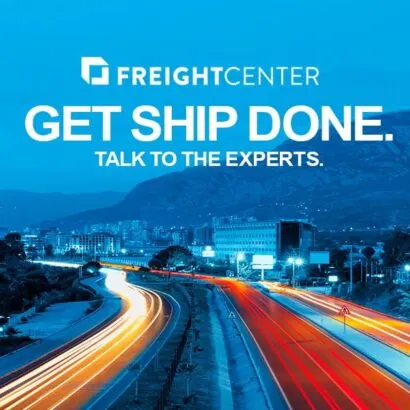
Easy Guide to Freight Class
Get your Easy Guide to Freight Class below where we further elaborate on how to determine the right class for your shipment.
Need an easy guide to understanding freight class?
Which do you think would be more expensive to ship, 50 pounds of feathers or 50 pounds of bricks? Think about it in terms of weight and freight density. If you guessed 50 pounds of feathers, you are correct. Why? Feathers are much lighter than bricks, but 50 pounds of feathers take up much space in the trailer. Our Easy Guide to Freight Class teaches you how to determine the right class for your shipment.
The NMFC® standard compares commodities moving in interstate, intrastate, and foreign commerce. It’s similar to other groupings or grading systems that many other industries use. Our guide takes the boring NMFC standards and makes them easier to understand.
Thousands of businesses trust FreightCenter to move their freight faster, smarter, and cheaper! From unbeatable rates to top-notch service, our customers are raving about their shipping success.
See why they keep coming back!
Award-Winning Service, Trusted by Shippers Everywhere!
- 2021, 2017 & 2016 Food Logistics’ Top Green Providers
- 2021 & 2018 Supply & Demand Chain Executives’ Pros to Know: Matthew Brosious
- 2020 & 2019 Top Food Logistics’ 3PL & Cold Storage Provider Award
- 2020 & 2019 Business Observer’s Top 500 Companies on the Gulf Coast
- 2020 & 2017 SmartWay® Transport Partner
- 2020 & 2017 Food Logistics’ Champions: Rock Stars of the Supply Chain
- 2020 Best of Palm Harbor Awards for Local Businesses
- 2017 Green Supply Chain Award from Supply & Demand Chain Executive
- 2017 Tampa Bay Business Journal Heroes at Work
- 2016, 2015, & 2012 Food Logistics Top 100 Software and Technology Providers
- 2013 Tampa Bay Business 100 by Tampa Bay Business Journal
- 2013 Top 100 Great Supply Chain Partners by SupplyChainBrain
- 2012 TIA Samaritan Award Honorable Mention
- 2012, 2011 & 2010 TBBJ Fast 50 Recipient
- 2013, 2011, & 2010 Diversity Business Top Businesses

Why Choose FreightCenter for Freight Shipping?
Expertise in Freight Shipping: With over 25 years in the logistics industry, FreightCenter is dedicated to guiding you through the entire logistics process, from beginning to end. Our goal is to make freight shipping easy to understand and book. Don’t waste time researching and receiving quotes from individual carriers- FreightCenter’s got your back!
Competitive Rates with Tailored Solutions: We prioritize high-quality customer service without breaking your wallet. We utilize our relationships with regional and national carriers to offer you competitive, affordable rates while providing personalized solutions to your needs. Need a liftgate? We got you! Want to expedite your order? Leave it to us! We’re ready to provide tailored solutions that don’t compromise your freight shipment.
Personalized Customer Support: FreightCenter is committed to satisfying our customers. Our friendly customer support team is here to help you every step of the way, from initial inquiries to post-shipment concerns. We handle all aspects of logistics, including tracking, paperwork, and communication with carriers, so you can focus on your business while we manage your shipment. Choose us for our reliable service and affordable quotes!
What is Freight Class?
The National Motor Freight Classification (NMFC) is a classification system developed by the National Motor Freight Traffic Association (NMFTA) to compare freight goods to standardize less-than-truckload (LTL) shipping rates. Before freight classification, carriers would price freight however they saw fit. The rates would vary drastically if you had gotten quotes from three different carriers! However, after the trucking industry was deregulated in 1980 with the Motor Carrier Act, carriers needed consistent, industry-wide standards for freight pricing.
This is where the NMFC system came in. By introducing a classification system, all carriers throughout the country (and beyond) had a way of knowing how heavy, dense, valuable, and portable an LTL shipment was. The freight class ensures that freight is identified and labeled correctly so carriers know what to expect while transporting the goods while also doing so safely and efficiently.
For example, say you have a large curio cabinet you want to ship to the other side of the country. The large and heavy cabinet contains a glass front and shelves, making it more fragile than other types of cabinets. While freight class does consider heaviness, the primary concern is its density and fragility; therefore, the glass parts, while not as heavy as the rest of the cabinet, will call for a higher freight class number. However, If the cabinet were made entirely of wood, the freight class number would be lower since it is more sturdy and handles transport better than a glass cabinet.
So the reasons why freight class is important are three-fold:
- Freight class ensures goods are transported safely. Carriers will know how delicate a shipment is and treat it properly during transport.
- Shipping rates are consistent with other carriers, ensuring a smooth LTL shipping experience.
- Shippers are not overcharged for incorrectly labeling their LTL shipments, which could lead to extra shipping fees if not corrected.
How Freight Class Works
The system created 18 freight classifications (freight classes for short) to standardize freight rates, with number codes ranging from 50 to 500. Again, the shipment’s regular weight does not entirely factor into how small or big the freight class number is; what matters more is how sturdy or fragile the freight good is. Specifically, there are four factors in determining your freight class:
- Density (the weight per cubic foot or how dense a good is compared to its dimensions)
- Stowability (how easy is it to stow a good onto a trailer without causing issues with other transported goods)
- Handling (how difficult is it to package and move a good during loading and unloading)
- Liability (how likely is it for a good to be damaged, stolen, or lost during transport)
Generally, low-numbered freight-class goods equal lower shipping costs, while high-numbered freight-class goods mean higher shipping costs. This doesn’t account for all goods; some goods may seem like the freight class will be lower, but some characteristics in their design or dimensions may mean the freight class is higher. Think of that curio cabinet: while the rest of the item may be wood or steel or another sturdy material, the glass parts mean the item is more dense, fragile, and valuable than an all-wood or all-steel cabinet.
Density is considered the most critical factor in determining freight class and requires extra math. Freight density is calculated using the following formula:
Freight Density (lbs/ft³) = Weight of Shipment (lbs) / Total Cubic Feet of Shipment
You need to multiply a shipment’s length, width, and height (in inches) and then divide the results by 1728 (the # of cubic inches in a cubic foot) to convert it to total cubic feet. Then, divide the shipment’s total weight by the total cubic feet to get the total pounds per cubic foot, which is the shipment’s density.
Too much math for you? Don’t worry; you don’t have to do it all yourself. You can use a freight density calculator to get the freight density. FreightCenter has a freight density calculator that does the calculations, so you can present it to a carrier or broker during booking to determine your freight class.
You also may not even need to do any calculations! Some websites like FreightCenter have online quote tools that define an initial freight class based on your shipment’s dimensions, weight, destination, and other factors. Later, when you speak to a freight agent, they will go into more depth about your shipment and determine a final freight class.
To create value for our customers by delivering customized shipping solutions that meet their unique needs and to fulfill shipping demands from simple to complex with expertise, guidance and ingenuity.
Rail shipping is a cost-effective and environmentally friendly transportation method that utilizes trains to move goods over long distances. It's known for its efficiency in handling large volumes of cargo, making it a sustainable and economical choice for businesses seeking reliable freight transport options.
Expedited shipping is a premium service designed to meet urgent delivery needs. It prioritizes speed and quick turnaround, ensuring that packages or goods reach their destination faster than standard shipping options. Expedited shipping is the go-to choice when time-sensitive deliveries are essential, providing businesses and individuals with reliable and prompt service for critical shipments.
White glove shipping is a premium service that goes beyond standard delivery, offering meticulous handling, specialized packaging, and in-home setup or installation for valuable or delicate items, ensuring a seamless and hassle-free experience for customers.
Less than truckload (LTL) shipping is a smart logistics solution for businesses with smaller shipments. It combines multiple smaller shipments into a single truckload, optimizing space and reducing costs. LTL shipping offers affordability and efficiency while ensuring timely delivery, making it an ideal choice for companies looking to save on transportation expenses without compromising on service quality.


FreightCenter is Here To Help You Ship Your Freight
FreightCenter knows how important it is to deliver your freight safely and punctually. With over 25 years in the business, we’re committed to giving our customers the best shipping experience without breaking your budget. We’re partnered with over 50 carriers nationwide, which we leverage to offer discounted rates you can’t find anywhere else. We also provide tailored solutions for your shipping needs, including expedited shipping, white glove services, and specialized freight shipping. And best of all, repeat customers can earn points for special rewards every time they ship with us!
Ready to ship something now? Our agents are prepared to help you get started on shipping right. Get a free freight quote using our free quote tool, or call us at (800) 716-7608.
Frequently Asked Questions about Freight Class and Packaging
Q. How does freight class affect packaging requirements?
A. Freight class plays a significant role in determining packaging requirements for shipments. Higher freight classes, which indicate higher density or greater difficulty in handling, often require stronger and more secure packaging to withstand the rigors of transportation. Proper packaging helps ensure the shipment arrives intact and undamaged, reducing the risk of costly freight claims.
Q. What packaging materials are suitable for different freight classes?
Packaging materials vary depending on the freight class and the nature of the items being shipped. For lower freight classes (e.g., Class 50-100), standard cardboard boxes and basic cushioning materials like bubble wrap or packing peanuts may suffice. However, for higher freight classes (e.g., Class 200-400), heavier-duty packaging materials such as double-walled corrugated boxes, wooden crates, or pallets may be necessary to provide adequate protection and support.
Q. How does improper packaging affect freight class determination?
Improper packaging can result in the reclassification of freight to a higher freight class. If a shipment is inadequately packaged and deemed more susceptible to damage during transit, carriers may reclassify it to a higher freight class to reflect the increased risk. This can lead to higher shipping costs for the shipper. Therefore, following proper packaging guidelines is essential to avoid unexpected reclassification and associated expenses.
Q. Are there specific packaging guidelines for hazardous materials in different freight classes?
There are specific packaging guidelines for hazardous materials based on their respective freight classes. Hazardous materials must be packaged according to strict regulations outlined by governing authorities such as the Department of Transportation (DOT) and the Occupational Safety and Health Administration (OSHA).
Packaging requirements may include using specialized containers, cushioning materials, and hazard labeling to ensure safe handling and transportation. It’s crucial for shippers to adhere to these guidelines to prevent accidents and ensure compliance with regulatory requirements.
3 Advantages of Freight Shipping With FreightCenter

25+ Years of Service
We have over 25 years of experience, as evidenced by our large network of professional carriers. Our knowledgeable team of shipping experts is ready to help you optimize your shipping experience.

Customizable Shipping Options
Need a liftgate? No problem! Need to ship your products quickly? We got you covered! Our FreightCenter agents can offer tailored solutions for your specific shipping needs while offering affordable rates you can’t find anywhere else.

Friendly Customer Support
Our customer support team has the answers to many of your shipping questions and concerns. We’re here to help you through every step of the shipping process, from initial inquiries to post-shipment issues.


